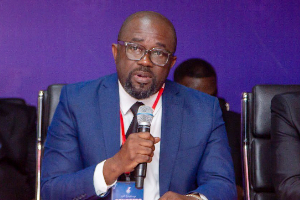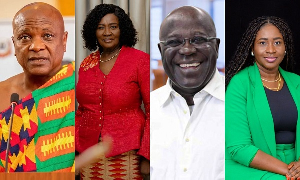2015 Republic Day Special!!!
Author: Prof Lungu
In the business of asset management, the concept of depreciation tells us that the longest period one can expect to receive benefits from infrastructure with typical repairs and maintenance, (i.e., "useful life"), is about 50 years. This goes for most major engineering feats.
Commissioned Saturday, 22nd January, 1966, Akosombo Dam was such a major financial and engineering feat.
Before 1962, the financial arrangements for the $324 million "Akosombo Hydo Electric Power-Volta Lake" plan was the most complex project ever attempted by the World Bank, the International Bank for Reconstruction and Development (IBRD), or by any entity in the world, including the United States. Funding in the form of loans was obtained from the governments of the United States and the United Kingdom. The Kaiser and Reynolds companies, representing "private enterprise", provided funds as well, including advances for purchase of power from the power plant yet to be built. The Government of Ghana provided $98 million, and guaranteed every loan. The Italian engineering firm, Impregilo, selected through competition, constructed Akosombo Dam under the supervision of Kaiser engineering while employing and training thousands of Ghanaian technicians and ancillary support personnel. Even more Ghanaians, from Accra, to Tema, to Afienya, provided massive amounts of sweat equity, or otherwise directly benefited, by the 1,000s.
Nearly 50 years later, Ghanaians continue to benefit, directly, and indirectly, from Aksosombo Power, every single day!
Fact is, the comprehensive, integrated "Akosombo Hydo Electric Power-Volta Lake-VALCO" project was the planned industrial, agricultural, and service industry "take-off" initiative for the fast-track development of Ghana in accordance with the vision of Dr. Kwame Nkrumah.
The record is in the data!
In six short years, between 1960 and 1966 (when Nkrumah was overthrown), Ghana's Gross Domestic Product (GDP) per capita jumped from $181.00 to $267.00, representing a 47% increase (or 7.83% each one of those 6 years). However, thirty (30) long years after the overthrow of Nkrumah, Ghana's GDP per capita was practically stagnant, increasing just 2.7% each one of those 30 years (from a low $214.00 in 1967 to $386.00 in 1997).
Approximately 400 kilometers long and with a surface area 8,502 square kilometers wide, the Volta Lake, on which sits Ghana's Akosombo Dam, was, and still is, the largest man-made lake in the world, providing important lessons in environmental governance; impact of development on humans, wildlife, and society; and human re-settlement, as a result of eminent domain. In short, the Ghanaian-owned Akosombo Hydro Electric Power dam, the anchor project of the integrated, multi-purpose and Multi-National/Public-Private-Venture (NM/PPV)©, was the first of its kind in the world. Its success served as a template for other grand development and reconstruction schemes sponsored by the World Bank and other global, multi-national development interests.
As planned and approved by Nkrumah, proceeds from sales of electricity to industry would pay off all elements of the $324 million loan project within 30 years, well before the end of the useful life of Akosombo Dam, the anchor asset. And so, as an example, in 1968, Ghana made the first payment on the $47 million IBRD loan. The final payment on the IBRD loan was in 1987, 25 years later.
The record shows that on 24th February, 1966, just thirty-three (33) days after Dr. Kwame Nkrumah commissioned the Akosombo Dam, he was overthrown by the Kotoka-Ankrah-military-police junta with the knowledge and assistance of Western powers, among them the United State, the United Kingdom, and France. Thereafter, for over 40 years, groups of governments failed Ghanaians each step of the way, among them the Kotoka-Ankrah/Rawlings military juntas of the 1960s-1970s, the Rawlings P/NDC-NDC governments of the 1980s-1990s, and the Kuffour NPP government of the 2000s.
It is our position that governments after Nkrumah neglected to add reserve power generation capacity to the Ghana power grid, and as a result, cheated Ghanaians of a key Kwame Nkrumah legacy dividend, (i.e., power and an industrialized Nation-State). In addition, those government neglected to properly and effectively police the agreements between Ghana and the aluminum consortium, (i.e.. Kaiser, Reynolds, VALCO), and as a result failed to ensure Ghana received a fair share of the economic gain and wealth, as landlord and owner of the input resources.
Acutely, for the Ghanaian condition, those governments as a group failed miserably to develop credible alternative power facilities even as they each attempted to "spread" grid-dependent electrification schemes to rural Ghana. Those governments failed to realize that, regardless of where their "brute power" or "electoral votes" came from, there was little economic justification for "grid-tied" rural electrification schemes. In particular, in Africa, there was never wisdom behind having rural dwellers who require just 4 watts of energy (for their lamps and mobile phones) hog the Akosombo-Takoradi-national electrical grid, in competition with industry and government.
So, coasting on the successes of Kwame Nkrumah and his CPP government after the commissioning of Akosombo Dam, the "Days of Reckoning" for Ghanaians begun to arrive thirty-two (32) years ago, in 1983, under Mr. Jerry "Accountability" Rawlings. During that "Rawlings-Year", industry in Ghana received less than 25% of their actual power requirements from the VRA. The crises would extend to 1996, still under Mr. Rawlings; and beyond, to Mr. Agyekum Kuffour's NPP government. In short, acute, rolling blackouts had become persistent in Ghana. The professionals in the "power circuit" called it "load-shedding". In homes throughout the breath of Ghana, it was "Dum-Sor" (Turn Off/Turn On).
At this point, we must remind the reader that the Akosombo power project was a major plank in the "Election Manifesto" of Nkrumah's CPP as far back as 1951. In fact, during 1952-1959, before financial arrangements were completed for Akosombo, Kwame Nkrumah, as head of government, risked everything and gave the orders for construction of elements of the multi-phase plan. As a result, facilities and environments constructed during 1952-1964 by the Nkrumah's "Orders" included the Tema Harbour, the Tema-Akosombo highway, sundry access roads to the site of proposed dam, and the Tema Township, itself.
Construction of the Akosombo Dam itself began in 1962 after the contract was signed by Mr. William M. Q. Halm, the Governor of Bank of Ghana at that time. When the dam was commissioned four years later in 1966, twelve (12) full months ahead of schedule, that singular event alone, in the words of Dr. Kwame Nkrumah, provided Ghana:
"...electric power nearly ten times...power production...(at that time)...from all sources...low-cost power for the development of tomorrow's Ghana."
In 1966, with more turbine engines ready to install for a total of 883 Mega Watts (MW), Ghana had at that point 512MW, more than enough for industry. To boot, reserve power from diesel generators all over the breath of the Ghana gave Ghana sufficient power for institutional and residential uses, too. In fact, in 1966, there was power for export, even as plans for further urban-rural electrification was proceeding, with "Atomic Energy" and "Solar Energy" strongly in the mix of Nkrumah's development vision for Ghana.
Regarding "Solar Energy", Haizel (1991) reported:
"...While speaking about atomic energy, Dr. Nkrumah charged the Ghana Atomic Energy Commission to investigate and expand research on the possibility of solar energy. This was to supplement work already begun at the University Science and Technology...”
Yes, dear reader, in the 1960s, before he was overthrown, the Visionary in Dr. Kwame Nkrumah was talking about "Solar Energy" as a resource in the streets and homes of Ghana, Africa, when Nkrumah was the leader of independent Ghana.
The tragedy for Ghanaians is, Dr. Nkrumah was overthrown in 1966 by "bona fide members of the Ghanaian military...(and)...rascal civilians...including...former prime minister (Busia)..." (Kwame Okoampa-Ahoofe, Jr, 2004).
Thereafter, it took practically 17 years before any government, military or civilian, would add to Ghana's electricity generation capacity. That occurred first via a World Bank loan for a second hydro power dam (Kpong). That contract was signed in 1977 by the Acheampong junta. That additional capacity came 5 years later, in 1982. However, the Kpong power project that was proudly commissioned by Mr. Jerry "Accountability" Rawlings merely added 160MW to Ghana's power generation capacity. Suffice to say that Kpong was never "an abundant and reliable source of water for power" by any standard, regardless of what Mr. Jerry "Accountability" Rawlings said during the commissioning of that project.
We will need to "fast-forward" in military-time another 15 years, to 1997, before "power-hugging" Jerry "Accountability" Rawlings would be able to increase Ghana's power generation capacity another 330MW, via the Aboadze Thermal Plant, in Takoradi.
To cut to the chase, in the span of 17 years, the government of Mr. Jerry "Accountability" Rawlings managed to add just 462MW directly to Ghana's power generation capacity even though long before 2001, when Kufour's NPP defeated the NDC in elections, the requirement for power exceeded 1200MW in extra power generation and reserve capacity. In 8 years, Mr. Kufour's NPP would add just 400MW, via Bui Dam, a project that was commissioned by President John Mahama, in 2013. As well, Mr. Kuffour and his NPP party flatly neglected to seek credible answers to Ghana's energy problems via Renewable Energy, even though the constraints of adequate water levels for Ghana's hydro power plants had been recognized as an acute problem decades before he assumed the Presidency.
So, effectively, in nearly 50 years, the combined power-generation output of all governments after Nkrumah succeeded in increasing Ghana's power generation capacity to a reported 2,936MW, top side. However, demand for power in Ghana has more than quadrupled, population alone having increased over three-fold, from approximately 8 million in 1966, to over 25 million in 2014. (The reader should kindly deduct Akosombo's 1,020MW current generating capacity from the total 2,936MW to get your net generating capacity, during all of the 50 years, after Nkrumah).
Moving forward, as the reader probably knows, 2,936MW national power generating capacity is not exactly equivalent to actual generating capacity, nor does it include industry standard "reserve power generating capacity". In effect, given today's requirements, these are power generating and distribution conditions far from what existed in Ghana in 1966, the year Nkrumah commissioned Akosombo Dam, before the "overthrow" by the "rascals".
In short, even with so-called Independent Power Producers (IPP) in the mix, generation of power in 2015 has consistently been about 500MW less than the actual requirement. That translates to hyper Load-Shedding, (i.e., extreme "Dum-Sor"), or the loss of jobs for more than 13,000 workers in Ghana; destruction of electrical equipment across the breath of Ghana, among them hospital equipment; and reduction in investments and other economic activities due to lack of power.
While others may attempt to apportion the blame for recurring, extreme "Dum-Sor" over the last 39 years to the International Monetary Fund (IMF) and the World Bank, etc., as far as we are concerned, this is the result of eleven (11) multiple foreseeable causes we will characterize as "Dum-Sor-Bioyin" (i.e., "'Dum-Sor' Sick Building") syndrome, a la the Japanese:
1. High cost of fossil fuel (lack of planning/hedging)
2. Lack of gas (no delivery or commitment) from Nigeria
3. Low water levels
4. Lack of timely maintenance and equipment failures
5. Lack of funds/non-payment of arrears by government, industrial customers, and residential consumers (arrears to ECG, GRIDCO, VRA)
6. Lack of vision and planning
7. Poor leadership and negotiation skills
9. Poor strategy in divestment state-owned enterprises, to include unreasonable tax holidays
10. Politicization of the Ghana development agenda - failure to act in the public interest
11. Corruption, bribery, nepotism.
We know the Kwame Nkrumah's record with respect to Items 6-11, from our "Dum-Sor-Bioyin" catalog of failures in governance.
To the point, there had never been, and there never was, "Dum-Sor" when Dr. Kwame Nkrumah was Leader of Government Business, Prime Minister, or President of Ghana, during 1951-1966.
On the contrary, there was CAPACITY!
Lots and lots of CAPACITY!
And Forward-Looking Development Plans to Boot!
As things stand, unlike South Africa's Jacob Zuma who may be able to blame his country's energy woes on apartheid and white oppression, Ghanaian leaders have nowhere to hide, after nearly half a century at the controls of government, post-Kwame Nkrumah.
In retrospect, given the facts as outlined and Nkrumah's bull-headedness for independent solutions for Ghana's development agenda, we can safely hypothesize that the 7-Year Development Plan unveiled in 1964 with focus on import substitution and national reconstruction would most likely have proactively addressed power generation capacity to the level required to support current needs, and the needs of "Ghana in the future", consistent with Nkrumah's vision for the development of Ghana, in Africa. In addition, we believe that Kwame Nkrumah would have effectively policed the agreements with the aluminum consortium, (i.e.. Kaiser, Reynolds, VALCO). In short, Nkrumah would have made sure Ghana received its fair share of the wealth created by the enterprises powered by Akosombo, as owner of the input resources in the first place.
We've addressed Nkrumah's plans for atomic energy and solar energy above! Those are crucial points, we must emphasize.
In short, but for the treason of "bona fide members of the Ghanaian military...(and)...rascal civilians...including...former prime minister (Busia)...", there would never have been "Dum-Sor" had Nkrumah's Vision been sustained, and his development plans allowed to evolve and manifest themselves in concrete forms throughout the breath of Ghana, from the South to the North, from the West to the East, and all localities in-between.
So now, the Rawlings-infested Mills-Mahama NDC government has famously run out of gas and energy, and "Dum-Sor-Bioyin" is at its severest Ghanaians have ever known.
However, rather than concentrating on solving the bread-and-butter problem of electric-power generation to the desired levels of reliability and sustainability, this same NDC government has signed a contract to purchase 5 military jets from Brazil. Cost for the jets is in excess of $55 million. At the same time, the Mr. Mahama government is proposing to privatize the more economically valuable elements of the Electricity Company of Ghana (ECG) through the Millennium Challenge Corporation (MCC), just as Mr. Kufour gave away Ghana Telecom's fibre-optic network to Vodafone for a song (as part of the privatization of Ghana Telecom). We must remind the reader that the ECG is still a state enterprise originally charted by Nkrumah and his CPP government, just as Ghana Telecom was.
Significantly, our review of the year-old "Ghana Power Compact" between the MCC, being a US-taxpayer funded agency, and Mahama's government (as signed by Mr. Seth Terkper, his Finance Minister), provides some rather unsettling insights. Suffice to say that the entire $535.6 million initiative ($38 million self-funded by Ghana), is curiously absent-minded of Renewable Energy (i.e., Photovoltaic (PV) Solar, Bio-Mass/Solid Waste, Wind, etc.). In fact, the development of Solar Energy is discussed just once, almost as a foot note, in the 75-page MCC "Second Compact with Ghana" thus:
"...support pilot tests and demonstrations of distributed applications (photovoltaic back-up power, solar powered street lighting) focused on Government electricity customers to reduce electricity consumption in Government facilities..".
Totally lost to us is how proud, professional, independent, and assertive Ghanaian officials acting in good faith on behalf of Ghana could agree to a weird US-centric, fossil-fuel dependent energy program that limits development of Renewable Energy (RE) to a "pilot test", that itself is limited to "government facilities". Consider that it is the same Mahama government that reported that "less than 1% of installed generation capacity was in the form of solar grid-intertied capacity...", in 2013. (In fact, the true answer to that one is 0 (zero)).
Our preliminary findings:
1. The MCC power initiative absolutely DOES NOT discuss wooing Ghanaians from the national electric grid using cheaper, more sustainable forms of renewable energy
2. The MCC power initiative absolutely DOES NOT address facilitating off-grid energy capacity for rural areas utilizing products and equipment available from countries other than the United States at lower prices
3. The big talk about "reform" of ECG is totally divorced from the Government of Ghana actually fulfilling its obligations to the ECG by simply paying the $375 million debt the government owes to the ECG.
4. Although the MCC agreement was signed in August of 2014, it is only recently that the Mahama administration has begun to discuss privatization of the ECG as stipulated in that agreement.
Reportedly, the $375 million owed by government to the ECG represents about 60% of all arrears owned to the ECG by all customers, including industry. However, the entire MCC agreement is worth $498 million in loans, and comes with over $133 million in tax free holiday benefits to the private interests during the 5 years of the program. On the other hand, Ghana must contribute $37 million to make the program whole and workable, in addition to guaranteeing the MCC loans.
As Yao Graham will have us know and understand:
"...A condition for the MCA grant is that debts due to the ECG are recovered so as to make it attractive for a private operator. The government has agreed a plan for clearing the debts. So perversely while government will not pay its bills to keep ECG alive it will urgently do so to prepare it for privatisation! Even more bizarrely after years of policies and practices that have weakened not only ECG but also the VRA it will ensure the profits of the private firms who will take ECG’s assets and the IPPs who will sell power through ECG!...Are we heading for the usual scenario where privatisation hands the cash cow to foreign firms while Ghanaian cronies are guaranteed crumbs from the high table?..."(Graham, 2015).
So, with all these factors, ails, and sickness, one must ask how and why Mr. Mahama could prioritize more than $50 million for 5 military aircraft over an indigenous solution to the ECG power given that over 60% of ECG arrears ($375 million) is still a bill for the Government of Ghana to pay.
There is always a precautionary note in these high-stakes matters that affect the fortunes of small countries with little political power. Just this week, Orimitsu Onishi reminded all of us, thus:
"...Nigeria’s leaders have promised a stable power supply since the end of military rule in 1999, spending about $20 billion and dismantling the state National Electric Power Authority, better known as N.E.P.A. — and widely derided as “Never Expect Power Always.” Yet the country’s power generating capacity has remained virtually unchanged, about six gigawatts for a country of 170 million. The United States, with 310 million people, has a capacity of more than 1,000 gigawatts..." (Onishi, 2015).
And so, we repeat: "There was no "Dum-Sor-Bioyin" under Kwame Nkrumah!
There never would have been "Dum-Sor" in Ghana but for that fateful day, nearly 2 (two) generations ago, when the Danquah-Busia-Dumbo-Confederate rascals, among them Dr. Kofi Busia, acted without regard to the interests of the People of Ghana, and betrayed Ghana, for a song, for "...$25 (not ten) thousand dollars..."
So it goes, Ghana!
SOURCES:
1. www.GhanaHero.com/Visions. Visit for more information.
2. Gov’t holds consultation on privatisation of ECG, General News, Ghanaweb, 22 June 2015.
3. Defend party’s achievements – Minister tells NDC youth, Politics of Tuesday, 26 May 2015, Ghana News Agency
4. Millennium Challenge Corporation - Ghana Compact, 5 Aug, 2014, https://www.mcc.gov/pages/countries/program/ghana-power-compact
5. Katharine N. Gratwick and Anton Eberhard. An Analysis of Independent Power Projects in Africa: Understanding Development and Investment Outcomes, Development Policy Review, 2008, 26 (3): 309-338, Journal Compilation © 2008 Overseas Development Institute (Blackwell Publishing, Oxford OX4 2DQ, UK and 350 Main Street, Malden, MA 02148, USA).
6. Kufuor backs privatisation of ECG, General News of Tuesday, 30 June 2015, Ghanaweb, http://www.ghanaweb.com/GhanaHomePage/NewsArchive/Kufuor-backs-privatisation-of-ECG-365514
7. E. A Haizel, (1991), “Education in Ghana, 1951-1966,” The Life and Work of Kwame Nkrumah, edited by Kwame Arhin, Accra, SEDCO, 55-87.
8. Inauguration of VOLTA POWER. www.GhanaHero.com Presents in True Context......Address by Osagyefo the President and other Speeches and Messages delivered at the Inauguration of the Volta Power, Saturday, 22nd January, 1966, Visit: http://www.ghanahero.com/Visions/Nkrumah_Legacy_Project/documents/deve_plans/Inauguration_of_VOLTA_POWER_22Jan1966.pdf
9. Yao Graham, 2015. The Electricity Company of Ghana (ECG) is a victim of Government Policies and Practices, Coordinator Third World Network-Africa.
10. Norimitsu Onishi. Weak Power Grids in Africa Stunt Economies and Fire Up Tempers, New York Time, 2 July, 2015, http://www.nytimes.com/2015/07/03/world/africa/weak-power-grids-in-africa-stunt-economies-and-fire-up-tempers.html?_r=0.
©Multi-National/Public-Private-Venture (NM/PPV)-Prof Lungu, 30 June, 2015.
©Prof Lungu is Ghana-centered/Ghana-Proud. Prof Lungu is based in
Washington DC, USA. Brought to you courtesy www.GhanaHero.com©1 July,
2015.
Opinions of Monday, 6 July 2015
Columnist: Lungu, Prof.














